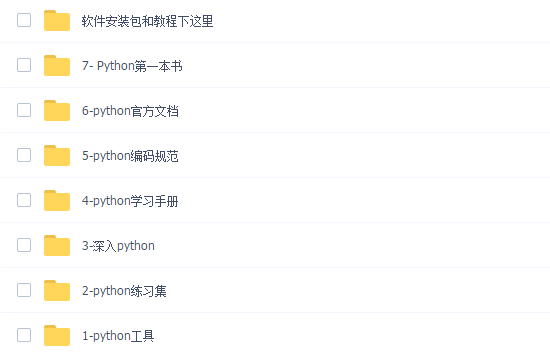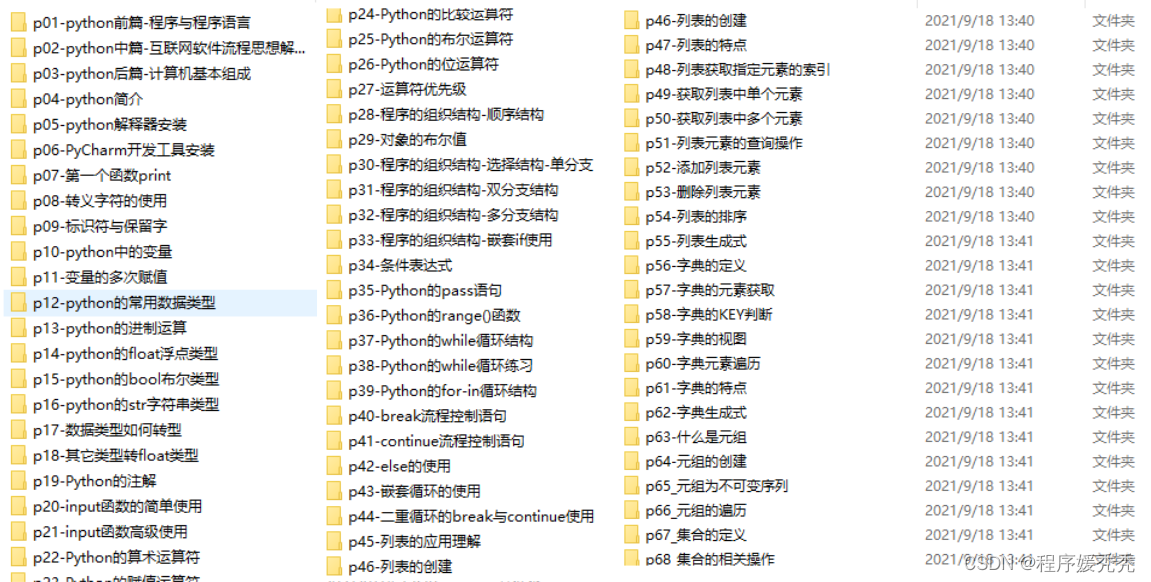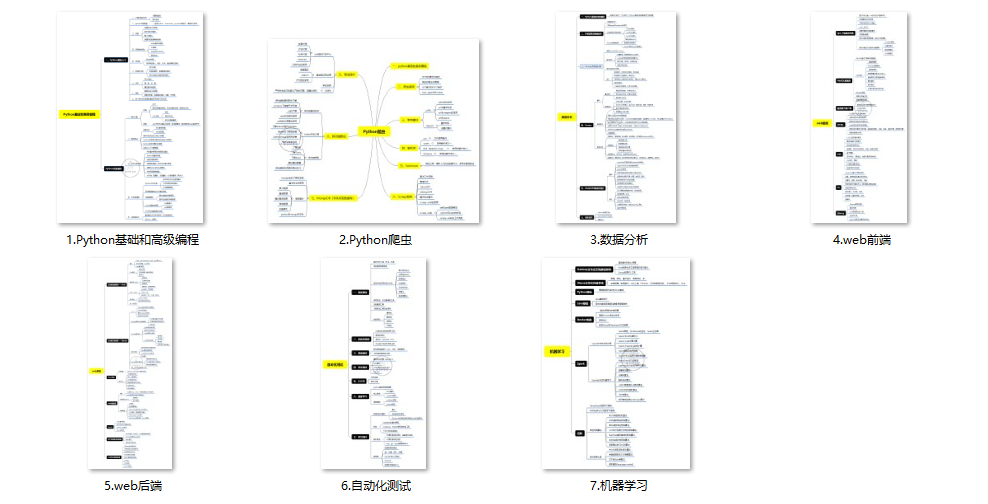一、Python所有方向的学习路线
Python所有方向路线就是把Python常用的技术点做整理,形成各个领域的知识点汇总,它的用处就在于,你可以按照上面的知识点去找对应的学习资源,保证自己学得较为全面。

二、学习软件
工欲善其事必先利其器。学习Python常用的开发软件都在这里了,给大家节省了很多时间。

三、入门学习视频
我们在看视频学习的时候,不能光动眼动脑不动手,比较科学的学习方法是在理解之后运用它们,这时候练手项目就很适合了。

网上学习资料一大堆,但如果学到的知识不成体系,遇到问题时只是浅尝辄止,不再深入研究,那么很难做到真正的技术提升。
一个人可以走的很快,但一群人才能走的更远!不论你是正从事IT行业的老鸟或是对IT行业感兴趣的新人,都欢迎加入我们的的圈子(技术交流、学习资源、职场吐槽、大厂内推、面试辅导),让我们一起学习成长!
min_samples_split: int
The minimum number of samples needed to make a split when building a tree.
min_impurity: float
The minimum impurity required to split the tree further.
max_depth: int
The maximum depth of a tree.
loss: function
Loss function that is used for Gradient Boosting models to calculate impurity.
“”"
def init(self, min_samples_split=2, min_impurity=1e-7,
max_depth=float(“inf”), loss=None):
self.root = None # Root node in dec. tree
Minimum n of samples to justify split
self.min_samples_split = min_samples_split
The minimum impurity to justify split
self.min_impurity = min_impurity
The maximum depth to grow the tree to
self.max_depth = max_depth
Function to calculate impurity (classif.=>info gain, regr=>variance reduct.)
self._impurity_calculation = None
Function to determine prediction of y at leaf
self._leaf_value_calculation = None
If y is one-hot encoded (multi-dim) or not (one-dim)
self.one_dim = None
If Gradient Boost
self.loss = loss
def fit(self, X, y, loss=None):
“”" Build decision tree “”"
self.one_dim = len(np.shape(y)) == 1
self.root = self._build_tree(X, y)
self.loss=None
def _build_tree(self, X, y, current_depth=0):
“”" Recursive method which builds out the decision tree and splits X and respective y
on the feature of X which (based on impurity) best separates the data"“”
largest_impurity = 0
best_criteria = None # Feature index and threshold
best_sets = None # Subsets of the data
Check if expansion of y is needed
if len(np.shape(y)) == 1:
y = np.expand_dims(y, axis=1)
Add y as last column of X
Xy = np.concatenate((X, y), axis=1)
n_samples, n_features = np.shape(X)
if n_samples >= self.min_samples_split and current_depth <= self.max_depth:
Calculate the impurity for each feature
for feature_i in range(n_features):
All values of feature_i
feature_values = np.expand_dims(X[:, feature_i], axis=1)
unique_values = np.unique(feature_values)
Iterate through all unique values of feature column i and
calculate the impurity
for threshold in unique_values:
Divide X and y depending on if the feature value of X at index feature_i
meets the threshold
Xy1, Xy2 = divide_on_feature(Xy, feature_i, threshold)
if len(Xy1) > 0 and len(Xy2) > 0:
Select the y-values of the two sets
y1 = Xy1[:, n_features:]
y2 = Xy2[:, n_features:]
Calculate impurity
impurity = self._impurity_calculation(y, y1, y2)
If this threshold resulted in a higher information gain than previously
recorded save the threshold value and the feature
index
if impurity > largest_impurity:
largest_impurity = impurity
best_criteria = {“feature_i”: feature_i, “threshold”: threshold}
best_sets = {
“leftX”: Xy1[:, :n_features], # X of left subtree
“lefty”: Xy1[:, n_features:], # y of left subtree
“rightX”: Xy2[:, :n_features], # X of right subtree
“righty”: Xy2[:, n_features:] # y of right subtree
}
if largest_impurity > self.min_impurity:
Build subtrees for the right and left branches
true_branch = self._build_tree(best_sets[“leftX”], best_sets[“lefty”], current_depth + 1)
false_branch = self._build_tree(best_sets[“rightX”], best_sets[“righty”], current_depth + 1)
return DecisionNode(feature_i=best_criteria[“feature_i”], threshold=best_criteria[
“threshold”], true_branch=true_branch, false_branch=false_branch)
We’re at leaf => determine value
leaf_value = self._leaf_value_calculation(y)
return DecisionNode(value=leaf_value)
def predict_value(self, x, tree=None):
“”" Do a recursive search down the tree and make a prediction of the data sample by the
value of the leaf that we end up at “”"
if tree is None:
tree = self.root
If we have a value (i.e we’re at a leaf) => return value as the prediction
if tree.value is not None:
return tree.value
Choose the feature that we will test
feature_value = x[tree.feature_i]
Determine if we will follow left or right branch
branch = tree.false_branch
if isinstance(feature_value, int) or isinstance(feature_value, float):
if feature_value >= tree.threshold:
branch = tree.true_branch
elif feature_value == tree.threshold:
branch = tree.true_branch
Test subtree
return self.predict_value(x, branch)
def predict(self, X):
“”" Classify samples one by one and return the set of labels “”"
y_pred = [self.predict_value(sample) for sample in X]
return y_pred
def print_tree(self, tree=None, indent=" "):
“”" Recursively print the decision tree “”"
if not tree:
tree = self.root
If we’re at leaf => print the label
if tree.value is not None:
print (tree.value)
Go deeper down the tree
else:
Print test
print ("%s:%s? " % (tree.feature_i, tree.threshold))
Print the true scenario
print (“%sT->” % (indent), end=“”)
self.print_tree(tree.true_branch, indent + indent)
Print the false scenario
print (“%sF->” % (indent), end=“”)
self.print_tree(tree.false_branch, indent + indent)
class XGBoostRegressionTree(DecisionTree):
“”"
Regression tree for XGBoost
- Reference -
http://xgboost.readthedocs.io/en/latest/model.html
“”"
def _split(self, y):
“”" y contains y_true in left half of the middle column and
y_pred in the right half. Split and return the two matrices “”"
col = int(np.shape(y)[1]/2)
y, y_pred = y[:, :col], y[:, col:]
return y, y_pred
def _gain(self, y, y_pred):
nominator = np.power((y * self.loss.gradient(y, y_pred)).sum(), 2)
denominator = self.loss.hess(y, y_pred).sum()
return 0.5 * (nominator / denominator)
def _gain_by_taylor(self, y, y1, y2):
Split
y, y_pred = self._split(y)
y1, y1_pred = self._split(y1)
y2, y2_pred = self._split(y2)
true_gain = self._gain(y1, y1_pred)
false_gain = self._gain(y2, y2_pred)
gain = self._gain(y, y_pred)
return true_gain + false_gain - gain
def _approximate_update(self, y):
y split into y, y_pred
y, y_pred = self._split(y)
Newton’s Method
gradient = np.sum(y * self.loss.gradient(y, y_pred), axis=0)
hessian = np.sum(self.loss.hess(y, y_pred), axis=0)
update_approximation = gradient / hessian
return update_approximation
def fit(self, X, y):
self._impurity_calculation = self._gain_by_taylor
self._leaf_value_calculation = self._approximate_update
super(XGBoostRegressionTree, self).fit(X, y)
class RegressionTree(DecisionTree):
(1)Python所有方向的学习路线(新版)
这是我花了几天的时间去把Python所有方向的技术点做的整理,形成各个领域的知识点汇总,它的用处就在于,你可以按照上面的知识点去找对应的学习资源,保证自己学得较为全面。
最近我才对这些路线做了一下新的更新,知识体系更全面了。

(2)Python学习视频
包含了Python入门、爬虫、数据分析和web开发的学习视频,总共100多个,虽然没有那么全面,但是对于入门来说是没问题的,学完这些之后,你可以按照我上面的学习路线去网上找其他的知识资源进行进阶。

(3)100多个练手项目
我们在看视频学习的时候,不能光动眼动脑不动手,比较科学的学习方法是在理解之后运用它们,这时候练手项目就很适合了,只是里面的项目比较多,水平也是参差不齐,大家可以挑自己能做的项目去练练。

网上学习资料一大堆,但如果学到的知识不成体系,遇到问题时只是浅尝辄止,不再深入研究,那么很难做到真正的技术提升。
一个人可以走的很快,但一群人才能走的更远!不论你是正从事IT行业的老鸟或是对IT行业感兴趣的新人,都欢迎加入我们的的圈子(技术交流、学习资源、职场吐槽、大厂内推、面试辅导),让我们一起学习成长!






















 5328
5328











 被折叠的 条评论
为什么被折叠?
被折叠的 条评论
为什么被折叠?








